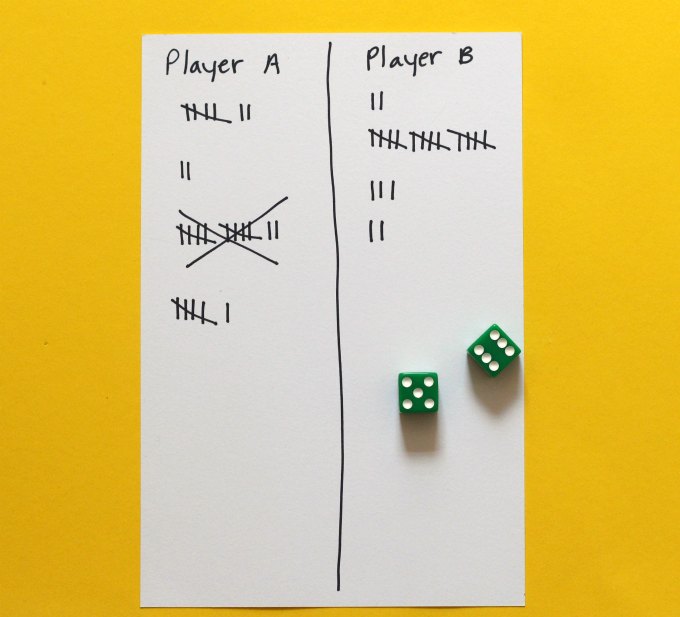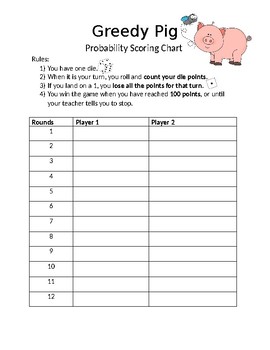How To Play Pig Dice
Players: 2 - 6
Ages: 6 and up
Cost: Free!
Math Ideas: Addition, probability
Questions to Ask:
What are the chances I roll a 1 on this turn?
If I want to score 20 points this round, what is the fewest number of times I will need to roll the dice? The most?
Let's say I make you a wager. You roll this die a certain number of times. At the end, I'll give you $100, so long as you never roll a 1. If you do end up rolling a 1, then you have to pay me $100.
How many rolls of the dice would you risk? Surely, you'd roll once, right? After all, the odds of winning are 5 out of 6. But only a fool would roll that die 30 or 50 or 100 times in a row.
So when does some outcome change from 'unlikely' to 'likely'? And how can you help your kids build an intuition for that idea, before they start wasting all their money on lottery tickets?
Maybe a quick game of Pig might help.
How to Play


How To Play Pig Dice
Sep 17, 2017 Game Play: Pig dice game is played with a single six-sided die and players are allowed to make any number of rolls in each turn. After each roll the dice value is added to their score for that turn. After each roll player can decide whether to stop rolling and claim the total turn score or continue rolling. If they roll a 1 then they lose all. Pass the dice to the next player. Ten Thousand Dice Game Rules #6. Be the first player to reach a score of 10,000. Once a player scores at least 10000, other players get one last turn each. If no one else scores 10,000, the first player who scored 10,000 wins.
Pig is typically played with 2-6 people. Each player needs a pencil and paper, as well as a single shared die.
On your turn, you roll the die. If you roll a 1, tough luck. Your turn is over and play passes to the next person. If you roll any other number (2-6), you add that score to your total.
You may roll the die as many times as you want, and you can end your own turn whenever you want. But if you ever roll a 1, you lose all the points you've gained that round.
So let's say on the first round, you rolled a 6 and decided to end your turn. On the next round, you roll four 5s in a row. Congrats! You have 26 points! But you decide to press your luck and roll one more time, landing on a 1. You lose your 20 points and return to a score of 6.
The first player to get to 50 points (or 100 points for a longer game) is the winner!
Where's the Math?
Games Played With Dice Only
Pig is my favorite game for teaching a counterintuitive, but important, truth of probability: Unlikely things happen. In fact, unlikely things are very likely to happen, eventually.
In Pig, the chance of rolling a 1 on the next turn is low. At every point along the way, you can justify one more roll. After all, the chances are only 1 in 6 that you'll lose your points. But the chance of never rolling a 1 on the next 10 turns is even lower. And if you roll the dice 100 times in a row, you're practically guaranteed to roll a 1 at some point.
So your child has to start thinking about how to make decisions about uncertain outcomes. Do they roll until they get 20 points, then end their turn no matter what? Do they roll the dice 5 times in a row and then end? Or do they, like most kids, get sucked into the siren's call of 3s and 4s and 5s, constantly telling themselves 'one more roll. Just one more and then I'm done.'
(By the way, as a parent, this game is a great way to determine which of your kids should NEVER go to Vegas)
Pig builds an intuitive understanding of chance and probability that is much more engaging than most games. Sure, there's an element of chance in just about every game. But Pig brings all that chance straight to the forefront of your child's mind, as they decide whether to keep their points or risk another role. This intuitive understanding of chance will give them a great foundation for a more formal academic exploration of probability in middle school.
This game is really popular in elementary classrooms because it also helps kids practice their addition skills, which is also great. The more math topics you can squeeze into a simple dice game, the better!
Questions to Ask
The big question to ask your child is 'What are the chances of rolling a 1 this time?'
The answer is, of course, 1 in 6. This is always true, no matter what happened last turn or the turn before that. The dice have no memory: they don't know what they rolled last time.
One time I went to a casino and saw all these roulette wheels that had displays, showing the red and black numbers that had won in the past. I always wondered if those displays trick people into making bad bets, waiting for a wheel to hit red seven times in a row, just so they can co bet on black. After all, there's no chance it hits red again, right? (Wrong).
This simple question brings up a deep tension in probability: beforehand, certain outcomes seem very unlikely. But each individual outcome has the same probability, regardless what happened before.
It's incredibly unlikely to flip a coin and land on heads 100 times. But if you've already flipped that coin 99 times and landed on heads 99 times, then what are the chances of landing on heads for that 100th flip? 1 in 2, just like every other coin flip ever.
Another great question to ask is 'Let's set a goal score for this round. If you want to walk away with 20 points this round, what is the fewest number of rolls you'll need? What is the greatest number of rolls you'll need?'
This question will get your kids adding mentally, trying to determine how many 6s, 5s or 4s they need to meet their goal. Then, they will have a better intuitive sense of how risky their goal score is.
So give Pig a try! It's fast, fun, and free. And, of course, there's all that math you can do with it.
Introduction: How to Play Pig(Dice)

Pig is a very easy dice game and very fun gamr
How To Play Pig Dice Game
Step 1: Objective of the Game
To score 100 points before your opponent
Step 2: What Do You Need
How To Play Pig Dice Game Youtube
A piece of paper
Pencil/pen/marker or any writing thing
2 dies that have 6 faces
Step 3: The Rules
- 2 ones are called snake eyes if you get them you lose your points for the whole game once I lost them at 96
- Roll on every turn
-Mark all your points on a piece of paper
-Roll 1 or more time until you want to
-if you get a one in any of your rolls you get a 0 for that round
-Miss a turn if you got Snake eyes
Step 4: The Game
-First roll your dice
-Add the Score you got,If you got a 1 your turn is over and put 0 for your score
-Roll again if you want to (Rolls as many times as you want if you feel you are lucky)
-When you are done the opponent does the same thing
- If you or your opponent gets snake eyes you miss a turn and lose all your points
-Mark all your points on a piece of paper even your opponents
-And don't forget to sum all your points for a round and when done for a game
Step 5: Winning
Have 100 points before your opponent
Step 6: Have Fun
Have fun playing.Questions? Comment below
Be the First to Share
Recommendations
/pic46134.jpg)
Organization Contest
3D Printed Student Design Challenge
Micro:bit Contest